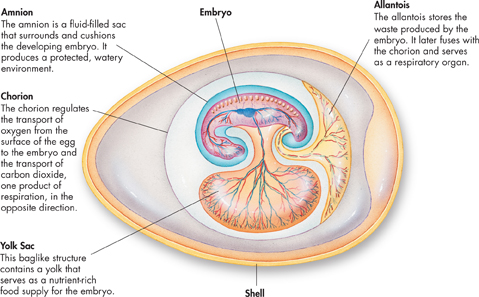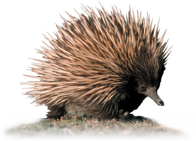
FIGURE 28–22 Amniotic Egg An amniotic egg contains several membranes and an external shell. Although it is waterproof, the eggshell is porous, allowing gases to pass through. The shell of a reptile egg is usually soft and leathery, while the shell of a bird egg is hard and brittle.
ddThe Amniotic Egg  Reptiles, birds, and a few mammals have evolved amniotic eggs in which an embryo can develop outside its mother's body, and out of water, without drying out. The amniotic (am nee AH tik) egg is named after the amnion, one of four membranes that surround the developing embryo. The amnion, yolk sac, chorion, and allantois membranes of the amniotic egg, along with its shell, provide a protected environment in which an embryo can develop out of water. You can learn about the functions of the membranes in Figure 28–22. The amniotic egg is one of the most important vertebrate adaptations to life on land.
Reptiles, birds, and a few mammals have evolved amniotic eggs in which an embryo can develop outside its mother's body, and out of water, without drying out. The amniotic (am nee AH tik) egg is named after the amnion, one of four membranes that surround the developing embryo. The amnion, yolk sac, chorion, and allantois membranes of the amniotic egg, along with its shell, provide a protected environment in which an embryo can develop out of water. You can learn about the functions of the membranes in Figure 28–22. The amniotic egg is one of the most important vertebrate adaptations to life on land.
Mammalian Reproductive Strategies Mammals have evolved various adaptations for reproducing and caring for their young.  The three groups of mammals—monotremes, marsupials, and placentals—differ greatly in their means of reproduction and development, but all nourish their young with mother's milk.
The three groups of mammals—monotremes, marsupials, and placentals—differ greatly in their means of reproduction and development, but all nourish their young with mother's milk.
▸ Monotremes Reproduction in monotremes, such as the echidna in Figure 28–23, combines reptilian and mammalian traits. Like a reptile, a female monotreme lays soft-shelled, amniotic eggs that are incubated outside her body. The eggs hatch in about ten days. But like other mammals, young monotremes are nourished by milk produced by the mother's mammary glands. Female monotremes secrete milk, not through well-developed nipples like other mammals, but through pores on the surface of the abdomen.

FIGURE 28–23 Monotremes There are only five species of monotremes, four of which are spiny echidnas similar to the one above. Monotremes lay eggs but, like all mammals, feed their young with milk produced by the mother.
Table of Contents
- Formulas and Equations
- Applying Formulas and Equations
- Mean, Median, and Mode
- Estimation
- Using Measurements in Calculations
- Effects of Measurement Errors
- Accuracy
- Precision
- Comparing Accuracy and Precision
- Significant Figures
- Calculating With Significant Figures
- Scientific Notation
- Calculating With Scientific Notation
- Dimensional Analysis
- Applying Dimensional Analysis




